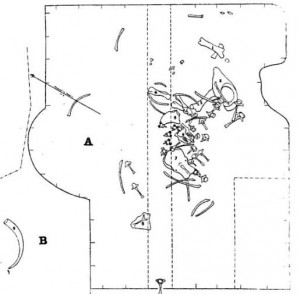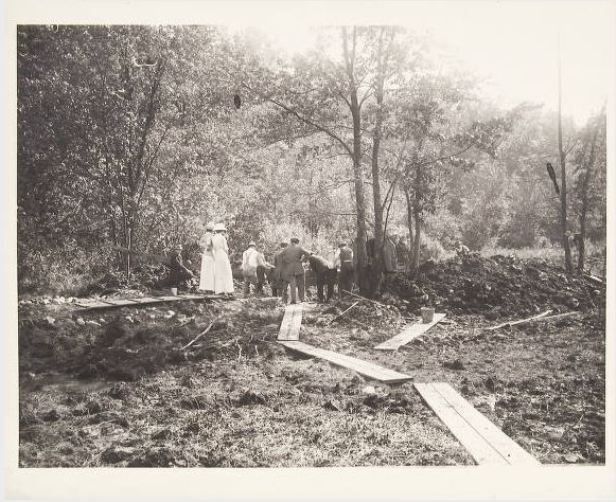On August 13, 1913, workmen unearthed the skeleton of a mastodon, in Farmington, while digging a trench on Alfred A. Pope’s farm and country estate, Hill-Stead. (Pope, age 71, had died just days earlier on the 5th.) The men were excavating to provide drainage for a piece of swamp land when they found what they believed to be the root of a tree about 4 feet below the ground’s surface. What they actually found was a large prehistoric bone. The superintendent, Mr. Allen B. Cook, immediately recognized the significance of their find and called in authorities from Yale University.

Diagram of the Farmington swamp showing the mastodon bones in situ, The American Journal of Science, 1914
Professor Charles Schuchert, head of the department of paleontology and historic geology, identified the bone and others found in its vicinity as part of a fore limb and the back of a skull belonging to an American mastodon, genus mammut. Experts from the Peabody Museum, assisted by the workers, took two weeks to exhume the rest of the skeleton by hand from the clay surrounding the bones. Almost all of the essential parts of the skeleton were recovered with the exception of the tusks, the small bones of the feet, some of the smaller leg bones, and caudal vertebrae from its tail.
In late November workmen again unearthed a large bone, this time it was one of the tusks. The earlier excavation had left a large hole that the men were turning into a water reservoir for the estate when they uncovered this new find. The tusk, measuring 23 inches at the widest diameter and 8 feet, 10 inches in length, was lying just 23 feet away from where the skull had been found. The “Pope Mastodon” would have stood 9 feet tall and weighed between 4 and 6 tons. A fossilized femur is held in the collection of the Connecticut Museum of Natural History at UConn’s Storrs campus.








